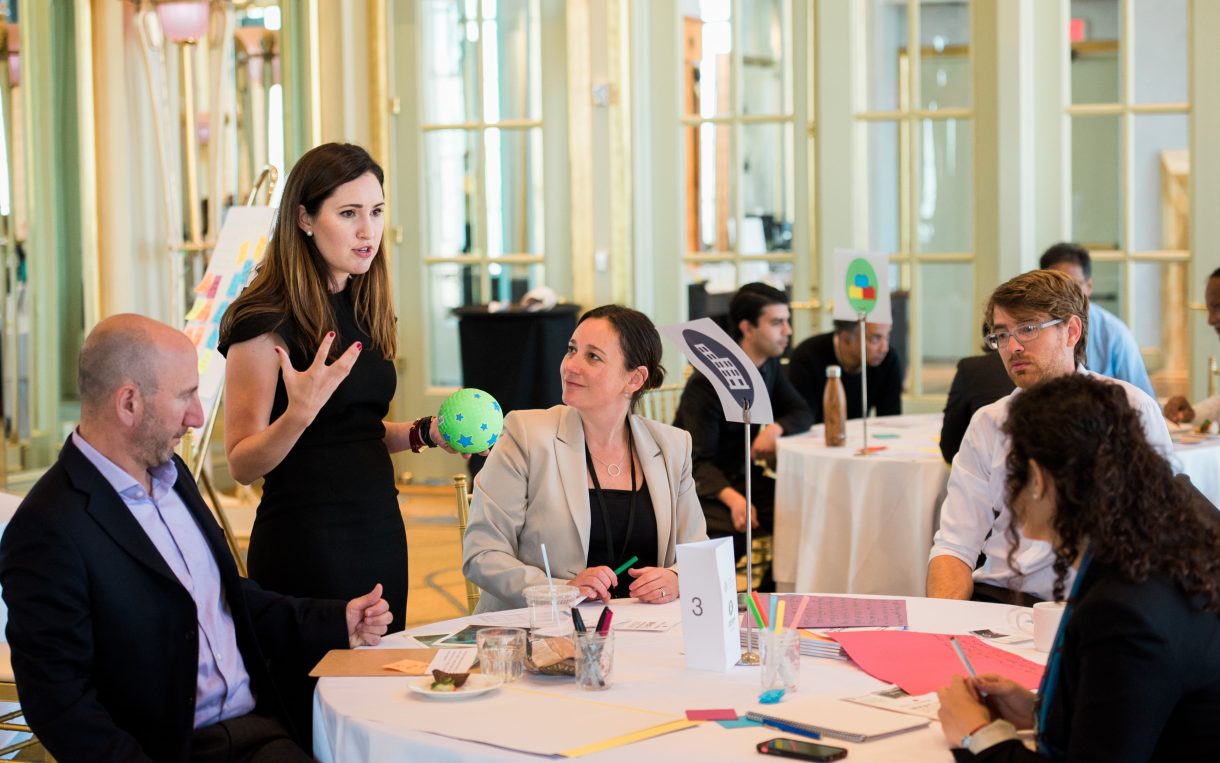Yet another boring panel discussion? No, thanks. The energy poor need new approaches.
 Facilitator interacts with participants at the Oxfam-World Resources Institute sponsored human-centered design workshop during the Clean Energy Ministerial in June 2016. (Photo: Vitaliy Prokopets, Pictilio)
Facilitator interacts with participants at the Oxfam-World Resources Institute sponsored human-centered design workshop during the Clean Energy Ministerial in June 2016. (Photo: Vitaliy Prokopets, Pictilio)
It’s time to get beyond expert panels, and involve the real experts: the poor themselves.
Is anyone else getting sick of the same old boring talk-fests and panel discussions sucking the life out of the issues we care about? We certainly are. So we decided to try something different.
Last month, world leaders met in San Francisco at the Clean Energy Ministerial to discuss clean energy solutions as part of global efforts to fight climate change. Given San Francisco’s reputation for disruptive thinking, we partnered with the World Resources Institute and an expert in Human Centered Design (more on that in a bit) to go beyond the usual talk-shops. We brought together different sets of expert—from policy and product design, to financing and implementation—all focused on designing solutions for the needs of the poor. Tellingly, trying something different seemed to get at the heart of the problem: putting the needs of the poor front and center, still remains our best bet, and yet is still not happening.
Despite the broad sets of skills, backgrounds, and even large sums of financing being put towards this challenge, the energy needs of the poor remain, disappointingly, largely unaddressed. I’ve written a lot about this in the past, and a recent example from a trip to Zambia shows how, despite good intentions, the energy poor are continually being left out.
Arts and crafts to the rescue?
The basic idea of human- centered design is to hone in on the lives and specific context of the people that we are serving, with a ground-up, empathetic lens. First, we take a wide view to fully understand the situation, including all the possible opportunities and risks; then move from there to drill down and focus on the specific issue at hand. It’s outside the box thinking with a more personal edge to it. A great example was its use in making MRI machines less scary for children.
It’s an approach that lends itself perfectly for understanding the multitude of challenges and different contexts that exist for the energy poor. Whether people are living in an apartment in Delhi, or a rural part of western Kenya; using firewood or propane; or needing energy for cooling or running a small workshop; human-centered design allows for a clear and complete problem definition born out of directly engagement with end users.

The drilling down is the fun part. During the workshop in San Francisco, we did get creative in trying to visualize, and even at times, physically design some of our solutions to get a feel of some of the practicalities. How exactly would one deliver a gas canister for a new type of generator? How would you store it safely in the home? Are you sure you want to put that near an open flame? Some of the conversations got very detailed, with elaborate designs to go with them (and for a hot minute made me miss my engineering days). Importantly, we took another step back and were encouraged to think big picture again about what we were trying to achieve with these new ideas. Keeping our eyes on the prize and making sure that any ideas have the best chance of actually working.
The poor aren’t just end users, they are THE key actors of the design process
Some parts of this approach are not necessarily novel, and are certainly applied disparately across the field of energy access. However, conducting this specific exercise yielded some interesting conclusions (beyond my inability to draw; I already knew that). The main thing that resonated, and indeed is persistent in the challenge of financing energy solutions for the poor, is that it’s not just that the needs of the poor are being left out of the energy solutions that eventually find their way to urban slums or rural settings; but rather that the poor themselves are being left out of the design process. They are the key actors that need to be brought in right from the start. Otherwise, key considerations about their needs– affordability, environmental challenges, family considerations, etc., get missed. The folks at SELCO have this down to an art (and we were glad to have them participate in our workshop).
Clean energy access has a lot of smart and dedicated people working on it. Thank goodness. The challenge of dramatically scaling up energy access for the poor and keeping it clean needs all the talent and commitment that can be mustered. Trying something new, could just be a new way to make sure such talent and commitment stays the course.
Thinking from a human perspective is what we try to do every day at Oxfam, and I know others in this field of energy, climate and social justice do as well. But sometimes it helps to try something different, to step outside of our day to day approaches, and in this instance see that we need to do a much better job of designing not just for the poor, but with the poor.